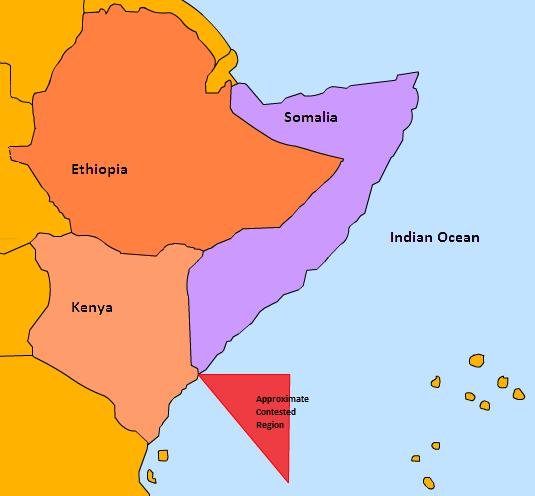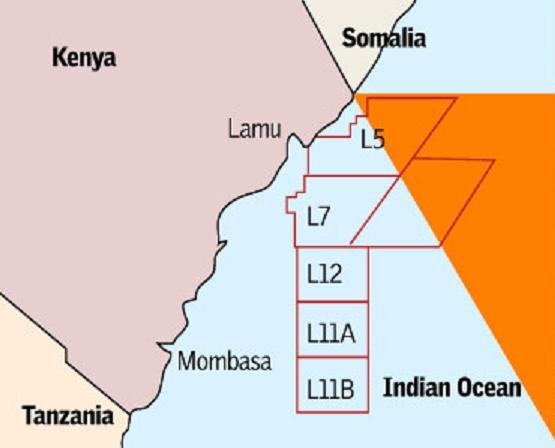STIRRING THE SOMALI WATERS: TOWARD A MARITIME OIL WAR?
- Posted by Cassie Blombaum on 10 Jun 2013 in Africa, Business Risk, Elections,
Energy, Exploration, Kenya, Military Activity, Political Risk, Somalia, United
States
Source:
http://blog.inkerman.com

The never-ending maritime dispute between Somalia and Kenya is, by now, well
understood. Indeed, since 1972, the two countries have been lobbying the UN to
see their side of the ‘Indian Ocean’ story. Reports of possible pirate political
involvement aside, for the most part, this disagreement has only been a war of
words. Going forward, it remains to be seen whether the two nations will engage
in a full-scale violent confrontation over the hydrocarbon-rich sea. If such an
event were to pass, however, Kenya is believed to have the upper hand. Indeed,
Nairobi has already secured enough powerful allies, including Norway, France,
and the US (all of which have stake in the Kenyan-authorised offshore oil
blocks), that would conceivably make a Kenyan victory a ‘sure thing’ from the
start.

For many armchair analysts, East Africa appears to have enough problems. Plagued
by pirates riding the waves of the Indian Ocean, and bullied by al Qaeda-linked
al Shabaab militants that threaten the very foundation of Somalia, the region
has been a constant focal point for insecurity. To be fair,
the pirates are
starting to let up. Moreover, the latest reports paint a picture of an
al
Shabaab on the decline – at least for now. However, a looming fight over oil and
gas could threaten to undue any transition toward stability in the region,
particularly when it comes to Somalia’s relationship with Kenya. Setting the Scene For Trouble
The latest East African scandal began with a seemingly innocuous clarification
by the Somali Government. Amid a weekly council of ministers gathering on 06
June 2013, officials decided to embark on the contentious topic of Somalia’s
maritime borders. By meeting’s end, the ministers had agreed to make “null and
void” the 2009 maritime borders Memorandum of Understanding (MOU) between Kenya
and Somalia’s now-defunct Transitional Federal Government (TFG). Adding fuel to
the fire, the Somali Government, led by President Hassan Sheikh Mohamud,
officially ‘extended’ the country’s sea territory by 200 nautical miles, and
also defined the continental shelf as part of its maritime boundary.
To the outside observer, this move may seem like a trivial declaration. Indeed,
Somalia and Kenya have been fighting over this very issue since 1972. However,
when given the fact that those 200 extra nautical miles could lead Somalia to
join the Indian Ocean hydrocarbon bonanza and simultaneously pit Nairobi and
Mogadishu in a fight over potentially lucrative reserves, this announcement is
far more consequential. Boundary Bickering So what, exactly, is the 2009 MOU? And better yet, why is Somalia keen on
supposedly ‘expanding’ its maritime boundaries? Whilst the general theme of the
MOU revolves around the issue of nation’s contested maritime borders, the exact
details and ultimate outcome of the memorandum
depends on which country you ask. For Kenya, the MOU had settled matters once and for all. Nairobi officials
believe that the April 2009 agreement signed by then-Kenyan Foreign Affairs
Minister Moses Wetangula, and his former Somali counterpart, Abdirahman Warsame,
allowed Kenya – not Somalia – to officially demarcate its maritime borders to
include the approximately 200 nautical miles off the coast of the Horn of
Africa. More precisely, for Nairobi authorities, the MOU extended the Kenyan
boundary east to approximately the 45° line of latitude. Naturally, Somali authorities offer a different view of the MOU signing. For
them, the memorandum only amounted to Mogadishu giving the “O.K.” for Kenyan
authorities to submit their version of the East African map. In other words,
Somalia sees the MOU as simply an ‘agree to disagree’ document. In Somalia’s
defence, this argument is not out of line, given that in order for a country to
officially submit its boundary map to the UN Commission on the Limits of the
Continental Shelf, it must provide proof that it has “cooperated with its
neighbours”. For Somalia, then, this document is only proof that it ried to
‘cooperate’. In the end, however, the Somali parliament rejected Kenya’s views
on the Indian Ocean boundaries in August of 2009; and the East African
neighbours have been squabbling over a body of water roughly 23,600 miles in
area ever since. Joining the Hydrocarbon Bonanza For Somalia, the fight over the maritime demarcation goes far deeper than a
quest for seaside riches. It is also a matter of pride. The view among many
Somalis is that their country has been taken advantage of, not only by Kenya,
but by international firms which they have accused of capitalising on their
decades-long lack of central government for their own financial gain. When Kenya
authorised another round of oil contracts in
July 2012, this time to include the
disputed Eni-controlled L21, L23, and L24 blocks, Somali authorities were quick
to cry ‘imperialism’. In particular, an angered Abdillahi Mohamud, who manages
the East African Energy Forum, claimed that these oil blocks, as well as the
Total S.A-controlled L22, the Anadarko Petroleum Corporation-bought L5, and
Statoil-run L26, were all sold off “illegally” by Kenyan authorities. Noted
Mohamud: “These offshore oil blocks are solely owned by the Republic of Somalia
as stipulated in the 1982 UN Common Law on the Sea (UNCLOS). Kenya’s move to
sell these oil blocks violates international law”. Indeed, for a country which
only recently managed to achieve a presidential election following decades of
bloodshed, Kenya’s oil block sell-off was not exactly a morale-booster.

Pride aside, the financial ramifications of the border demarcation is clearly of
importance as well. Whilst the exact amount of hydrocarbon reserves in the
23,000 square miles of water remains unknown, some reports have estimated that,
when combined with its reported onshore reserves, Somalia could have as much as
110 billion barrels of oil. With regard to offshore gas, in total the East
African region is believed to have
440 trillion cubic feet of recoverable
reserves. Clearly any slight ‘cheat of hand’ with regard to the Somali
boundaries with Kenya could spell billions of dollars in lost revenue for the
fledgling government in Mogadishu. The Way Ahead The never-ending maritime dispute between Somalia and Kenya is, by now, well
understood. Indeed, since 1972, the two countries have been lobbying the UN to
see their side of the ‘Indian Ocean’ story. Reports of possible pirate political
involvement aside, for the most part, this disagreement has only been a war of
words. Going forward, it remains to be seen whether the two nations will engage
in a full-scale violent confrontation over the hydrocarbon-rich sea. If such an
event were to pass, however, Kenya is believed to have the upper hand. Indeed,
Nairobi has already secured enough powerful allies, including Norway, France,
and the US (all of which have stake in the Kenyan-authorised offshore oil
blocks), that would conceivably make a Kenyan victory a ‘sure thing’ from the
start. This is not to say, however, that the Somali Government will not try to change
the Kenya-as-East African-powerhouse narrative. To be sure, in 2012, the Somalia
Government went ahead and announced that it, too, would auction approximately
“308 newly delineated oil blocks”, without seeking a cooperation agreement with
Kenya. Of course Somalia does not want to anger its neighbour. In their weekly
meeting on 06 June 2013, cautious ministers did state that, whilst they would
seek to implement changes to their national territory, they are looking
“forward” to working with Kenya, and “the government of President [Uhuru]
Kenyatta Kenyatta”.
http://blog.inkerman.com/index.php/2013/06/10/stirring-the-somalia-waters-toward-a-maritime-oil-war/
Source:
http://blog.inkerman.com
Faafin: SomaliTalk.com | June 11, 2013
|
